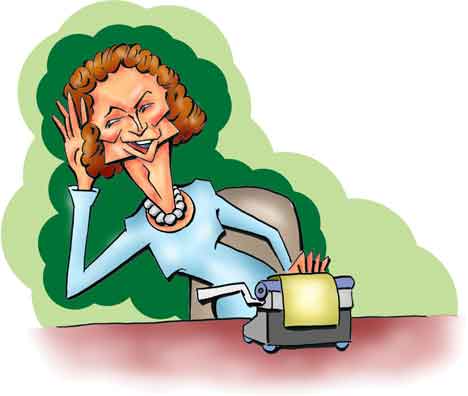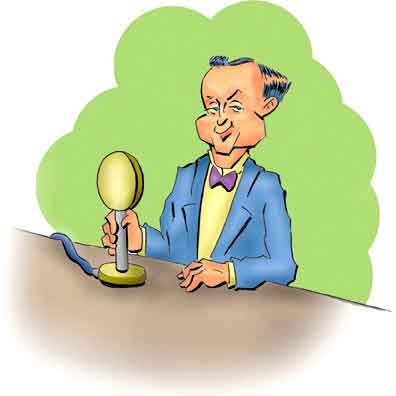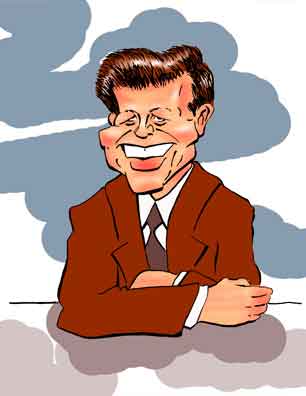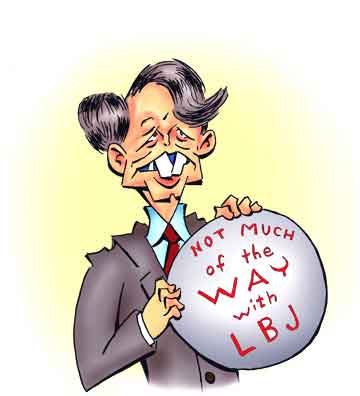Dorothy Kilgallen
To Celebrity with Celerity

Dorothy Kilgallen
What was her line?
In 2014, BBC Television mandated that their increasingly popular celebrity quiz shows would have at least one woman on the panel. The programs had become just too much of a guys' fest. Even if the ladies were not being deliberately excluded1, the format had far too much masculine brouhaha.
Footnote
Ergo, even if any disproportionate underrepresentation was due to "unconscious bias."
However, such managerial action hadn't been necessary more than sixty years earlier - at least not in the CBS studios in New York City. February 2, 1950 saw the first airing of What's My Line. This was a television program where a panel of celebrities tried to guess a contestant's occupation. Later in the show a famous "Mystery Guest" would show up and the panel had to guess, not the occupation, but who it was.
But on this first show the panel was made up of three guys and a gal. Admittedly by today's quiz-program standards, these guys were a strange lot. You had "the famous neuro-psychiatrist2" Dr. Richard Hoffman, former governor of New Jersey Harold Hoffman, and the balding bespectacled poet Louis Untermeyer. Yes, a shrink, a gov, and a rhym.
Footnote
Just like Snoopy said about world famous grocery clerks, there are probably no more than a dozen famous neuro-psychiatrists.
The gal, of course, was Dorothy Kilgallen. Beginning with the conventions that the panelists introduced each other, Louis said that Dorothy was his "favorite Broadway columnist and girl about town". At the time Dorothy was indeed writing a column called "The Voice of Broadway". She and her actor and theatrical-producing husband, Dick Kollmar, also had a daily radio show, Breakfast with Dorothy and Dick. The show was broadcast from their home and they talked about films, books, and commercial products with their kids showing up from time to time. The show was quite popular and ran from 1945 to 1963.
We must be honest and say that Dorothy is often characterized not as a pioneering investigative reporter but as a gossip columnist. Well, the latter designation is true enough, we suppose. By definition news about celebrities and their personal doings pretty much falls under the definition of gossip. On the other hand Dorothy saw herself as a bonafide reporter who could ferret out a story better than most.
Dorothy had come from a newspaper family. Her dad, James, was a well-known journalist who worked for UPI and International News Service. Bitten by the news bug, Dorothy had dropped out of college to be a full time reporter and by the age of twenty she was putting her by-line on stories in the New York Journal.
This was a day when news reporting itself was big news and the papers wouldn't hesitate to indulge in a bit of publicity seeking themselves. In 1936, the paper sponsored Dorothy in a race around the world (albeit on commercial airlines) and after 21 days she came in second to Bud Elkins (who wrote for the New York World-Telegram). Naturally Dorothy's Around-The-World-In-21-Days brought her additional notice.
The New York Journal was owned by (who else?) William Randolph Hearst, the news-creating super-publishing magnate who some think was responsible for pushing the United States into the Spanish-American War. He also owned the New York Evening Journal and in 1937 the papers merged to become the New York Journal-American. The next year Dorothy began "The Voice of Broadway" which was soon picked up for syndication. Ultimately it's been estimated that Dorothy was reaching twenty million readers.
The output of the Journal-American - and others of the Hearstian papers - has sometimes been referred to as "yellow" journalism, a now rather obsolete term that has been replaced with the "tabloid" designation. But ultimately it means going for sensational stories without worrying too much about checking the facts.
Avoiding joining into any fray, we will nevertheless point out that Jimmy Breslin, the New York reporter and Pulitzer Prize winner, characterized the Journal-American as a paper where "you couldn't even believe the weather report." Of course given the accuracy of weather reports that's not particularly severe criticism. But regarding Dorothy's columns, any complaints were less about the accuracy of her accounts than simply that the principals mentioned didn't want their personal doings splashed about in newspapers from coast to coast.
But for all her work in journalism and her nearly two decades on her radio program, it was the weekly appearances on What's My Line that garnered Dorothy her iconicicity. But Dorothy kept writing articles and her columns until her death on November 8, 1965, literally right after her last What's My Line appearance.
You'll read everything from Dorothy "dying in her sleep" to that she was murdered to keep her from divulging what she had learned about the JFK assassination3. But what is clear is that she died from a combination of drugs and alcohol4.
Footnote
Today it's become almost impossible to get the facts behind what are characterized disparagingly as conspiracy theories. But there is one telling point to remember when assessing individual stories about - quote - "what really happened" - unquote - to JFK and such stories. Supposedly you have a massive conspiracy that involved groups like the KBG, CIA, Fidel Castro's Secret Police, the Mafia, and who knows who else - and that these groups could assassinate an American President, control major parts of the government, cover up what happened, and do away with the early witnesses and investigators. And yet they can't stop a later author from publishing a book that tells all about it.
Footnote
It was no secret that both Dorothy and her husband had problems with alcohol, a problem at least in part fueled by their hectic lifestyles. Dorothy not only had to pound the pavement for information, write her columns, and then have to get up in the morning for her and Dick to do their radio program which aired every day - and we mean every day. Sundays for Dorothy were particularly grueling. She had to do the radio show and then at night she had to make it to What's My Line before the 10:30 p. m. starting time (the show, remember, was broadcast live). The program would end at 11:00 and then she had to get home and then wake up in time for the Monday morning radio broadcast. Dorothy and Dick also had three kids to raise.
As you expect there's been much ado about reported discrepancies in the coroner's inquest. First Dorothy was found in a large bedroom where she normally did not sleep and she had a book open in her lap although she did not have her reading glasses. Clearly, some say, a staged fake accidental overdose by nefarious and evil people.
The rebuttal is that she was not necessarily intending to go to sleep at that moment and that room was simply a good place to lay back and relax. As far as her not having reading glasses, there are photos of her typing and reading copy without her glasses. Of course there's always rebuttals to those rebuttals and you can rebut any rebuttals by rebutting ad infinitum.
As far as the stories that there were unprescribed drugs detected by the toxicological tests, it's not unknown for people, including celebrities, to obtain drugs through, well, let's say through irregular channels.

John Charles Daly
The First Pick
As a panelist Dorothy wasn't just picked out of the blue. Executive producer Gil Fates and his crew had auditioned a number of local celebrities - their budget wouldn't allow too much travel expenditures - and in the end they picked their first panel along with the moderator who was television and radio newsman, John Charles Daly. Despite John's prestige - he was the first newsman to broadcast the news of Pearl Harbor even as the attacks were happening - given the awkwardness of the set and performances on the first show, Gil later expressed incredulity that the program was ever given the nod to continue. In the end, the show ran for a total of 25 years, first as a live broadcast then taped for syndication.
The panel was fairly fluid for the first few years. Dorothy stayed but the three guys left in short order. But it was on the second show that actress Arlene Francis showed up and she remained for the duration. Afterwards it became de rigueur in  that celebrity panel quartets featured two ladies.
that celebrity panel quartets featured two ladies.
One of the forgotten panelists - virtually no one today remembers him - was writer and comedian Hal Block. With the fourth show he became a regular. But in a few years Hal was moved out, partly at least because of his (for the time) risqué comments and (particularly now) inappropriate behavior such as at times kissing the women contestants, which once was Neva Jane Langley who was Miss America for 1953. But earlier that year, Random House owner and publisher Bennett Cerf had come on as a guest panelist. Then with Hal's departure, Bennett became the third regular panel member and was eventually seen as the leader of the pack. The fourth slot went to a guest panelist.
Dorothy had one particular trait. While the other panelists joked and joshed, she played the game to win. Once Bennett found her in tears after the show. He asked what was wrong and she said she hadn't guessed a contestant's occupation in three weeks5.
Footnote
Bennett himself was competitive in a number of ways that exasperated the show's producers. For instance, he prided himself on guessing the identity of the Mystery Guest and he did so with such facility that viewers suspected he had been tipped off. But what Bennett would do was first scour the papers to find out which celebrities were in town and when and where they were appearing. So by broadcast time he had a pretty good idea of who was available. Bennett would sometimes guess the Mystery Guest after only a couple of questions and before any of the other panelists had a crack at it.
In the first shows the panelists would ask a question and keep asking them until they got a "No" answer. Then the next panelist would take over. But to counter Bennett's modus operandi, the producers began to make sure that he was the last to question the Mystery Guest, and they also changed the question format so that for the Mystery Guest the panelists asked only one question at a time.
Dorothy sometimes had to miss a show due to her journalistic commitments (like attending Queen Elizabeth's coronation where her limousine was actually in the procession). Another fairly extended hiatus was in 1954 when she covered the trial of Dr. Sam Shepherd, an osteopathic surgeon who was accused of killing his wife.
As many people know, Dorothy ended up thinking that Sam was innocent. Her belief that Sam was getting far less than the constitutionally guaranteed free and impartial trial was solidified when judge had told her that Sam was "guilty as hell". Then after Sam had been convicted, Dorothy reported the quote to Sam's new attorney, F. Lee Bailey. Lee eventually won a reversal of the conviction although the evidence for a hostile press was a major factor in the appellate courts' decision. But rather than letting Sam go, the district attorney said they'd retry the case. Lee, though, managed to secure Sam's acquittal6.
Footnote
For what it's worth, the opinions of Sam's guilt have never congealed. The conclusions of the authors flip back and forth with each new book and it's unlikely that a historical consensus will ever be reached.
Sam's later life was not a happy one. He had financial and personal problems, drank heavily and eventually had to abandon his medical practice. To make money he became a professional wrestler as - get this - "Killer" Shepherd. Sam died at age 46 of liver disease.
Once Dorothy was able to get a scoop from the What's My Line show itself. Mike Wallace, eventually to host 60 Minutes, was to be the Mystery Guest. But Mike had just interviewed gangster Mickey Cohen, an interview which due to Mickey's impulsive characterizations of public officials landed Mike and ABC in hot water. Because of the problems Mickey's interview caused, John didn't think he would be able to sit next to Mike with both of them smiling as if nothing had happened. Besides John had never thought that Mike was a real news reporter7 anyway. So the producers called Mike and he quite politely agreed to bow out. Then a quick call secured Sammy Davis, Jr., as the Mystery Guest.
Footnote
In his early years Mike was not the hard-hitting inquisitor which garnered him his ultimate fame. In addition to being an announcer and pitchman for products like Halo shampoo and Parliament cigarettes (Mike was a heavy smoker), he was a game show host for six - count 'em - six shows which are now all totally forgotten. These were (in order of broadcast) "Majority Rules" (1949 - 1950), "Guess Again" (1951), "I'll Buy That" (1953-1954), "Who's the Boss?" (1954), "The Big Surprise" (1956 - 1957), and "Who Pays?" (1959). He also once stood in for Bud Collyer on To Tell the Truth.
Even after Mike hit the really big time as one of the toughest news reporters en el mundo, his non-news origins would sometimes be pulled up. One critic dismissed Mike merely as an actor who played being a reporter, but naturally we feel such a statement is too harsh.
But the next day a story about the hassles with Mike and his last minute replacement appeared in the Journal-American. Although the article had no by-line, the writing was vintage Kilgallen. John Daly was so ticked at Dorothy he didn't speak to her for six months except as needed for the show.
And c'mon, we have to admit it. For all her congeniality on What's My Line, in print Dorothy could indeed make comments that went beyond our standards of good taste. On November 29, 1961, the Grand Ole Opry was going to play at Carnegie Hall, and Dorothy had been making some rather sniping comments almost daily about the "hillbillies" invading the hallowed walls - remember Carnegie Hall opened in 1891 with a concert in which Tchaikovsky himself had conducted. "Everybody should get out of town," Dorothy wrote, "because the hillbillies are coming!"
When Patsy Cline, who was going to appear, heard of Dorothy's less than charitable comments, she responded "At least we ain't standing on New York street corners with itty-bitty cans in our hands collecting coins to keep up the opera and symphonies." It's hard to tell what either Dorothy or Patsy was driving at.
Dorothy's columns could be as notable for what they did not say as much as what they did. In 1962 Dorothy wrote about Marilyn Monroe whose career had fallen into decline. Marilyn's most recent movie Something's Got to Give had been canceled because she kept calling in sick. She had been well enough, though, to fly to New York and sing "Happy Birthday" to JFK in Madison Square Garden as well as attend other functions. So on August 3, 1962, Dorothy wrote "Marilyn Monroe's health must be improving. She's been attending select Hollywood parties and has become the talk of the town again." Marilyn was found dead two days later.
That particular column has been cited by authors as Dorothy being one of the first journalists to reveal that Marilyn and John Kennedy were - ah - "involved". She had also mentioned that Marilyn was seeing a man who was "bigger than Joe DiMaggio in his heyday". Certainly JFK could fit the description, but then so could his brother Bobby. You'll also find - "quote" - supporting documents - "unquote" - for Dorothy's column being about the Kennedys, at least one of which didn't surface until 50 years later when it was posted on the Internet. Naturally some question the authenticity of such documents.

Was it JFK...

... or Bobby ...

...who was bigger than Joe?
Dorothy had been personally acquainted with JFK and she openly questioned the Warren Commission's findings. She never believed that Oswald acted alone and managed to print Jack Ruby's statements before they were officially released. You will read how Jack had refused to testify to the Commission unless he was taken to Washington and that he felt his life was in danger. The assumption (we guess) is that Jack wanted to tell of some massive underworld and international spy conspiracy in the assassination.
You do wonder, though, except for the fact that someone in the Warren Commission staff was slipping Dorothy information, why the Commission had any beef. If you read all of Jack's testimony you find he wanted to go to Washington so he could take a credible lie detector test (presumably at the FBI headquarters). Earl Warren - at the time the Chief Justice and head of the inquiry - told Jack they didn't insist he take the test and in fact given the vagaries and uncertainties of the polygraph actually suggested he not. But if Jack wanted to, they would help him set the test up.
And what Jack said - repeatedly - is that he had not shot Oswald as part of any underworld connection and he, Jack, had acted completely on his own. Of course the debate goes on whether Jack was telling the truth. In fact the psychiatrist who examined Jack said he was a "psychotic depressive" and that a lie detector test would be completely meaningless8. But in the end, Jack did take the polygraph test and he took it in Dallas.
Footnote
J. Edgar Hoover even got into the act. He pointed out that a polygraph, although called a lie detector, was in fact, nothing of the sort. It registered physiological responses which theoretically some thought correlated with the subject's attempt to deceive. For those who don't know it, the actual polygraph was invented by William Marston who also invented the comic strip character Wonder Woman.
And Dorothy and Jack? Well the story you'll read is that Dorothy said after a private interview with Jack that she had information that would "blow the case open". However, one author maintained that the private interview was simply her talking to Jack for a few minutes during a trial recess while other reporters stood around. You'll also read that her book manuscript on the Kennedy assassination mysteriously disappeared - or maybe it was just a chapter about Jack or perhaps that she hadn't yet written anything down or that there wasn't any "scoop" at all.
Dorothy's absence left a troublesome void in the What's My Line panel and at first the decision was to find a permanent replacement. But none of the possibilities really panned out, so the studio decided to stick with Bennett and Arlene as the permanent panelists and have two guests. Some of the temporary panelists, though, like actor (and Arlene's husband) Martin Gabel, had semi-permanent status.
Of course we can't talk about Dorothy, Arlene, Bennett, or John without talking about their first sponsor. That was Stopette which was a deodorant that came in a plastic squeeze spray bottle.
The head of the company was - and we quote - "Dr. Jules Montenier, the Famous Cosmetic Chemist". Actually no one knew who Jules was until the announcer mentioned he was famous and like grocery clerks and neuro-psychiatrists, there's hardly a dozen famous cosmetic chemists in the world.
What's My Line continued as a live black and white program until 1967. Then the next year it went into syndication - and in color and with a new host. Given the era, the sets were made to have what commercial television network executives thought a flower-powered hippie set should look. Another innovation (if you want to call it that) was that the syndicated shows had no specific sponsor and to make ends meet and pick up the extra cost, the number of commercials per half hour show was upped from three minutes of ads to six. And we know where that had led to.
Another difference of the syndicated shows was that instead of shooting one show per week as for the live show, they now had the luxury of taping five shows per day. So they could tape the year's show in a relatively short schedule.
Bennett Cerf died in 1971, but Arlene stayed on the panel until the 1974 season. Then in 1975 the show closed down for good.
References and Further Reading
Much of the information about Dorothy is in bits and pieces. There have been a number of books either about her or that mention her in various contexts, but their conclusions and interpretations of salient events vary widely. It's assumed that the reader can delve into these tomes on their own. But the following books, articles, and references may be of interest.
What's My Line?: The Inside History of TV's Most Famous Panel Show, Gil Fates, Prentice-Hall, 1978
"BBC Pledges It Will Put At Least One Woman On Every Comedy Panel Show - But Will It Make a Difference?", Ben Hamilton, The Telegraph, February 14, 2014.
"A Short-lived (But Not Completely Vanished) Newspaper", Christopher Bonanos, The Intelligencer, September 12, 2016.
"James L. Kilgallen Dies at 94; A Reporter for Over 75 Years", Frank Lynn, The New York Times. December 23, 1982.
"U.S. Diplomacy and Yellow Journalism, 1895-1898", Office of the Historian, US Department of State.
What's My Line, John Daly (Moderator), Richard Hoffmann (Panelist), Louis Untermeyer (Panelist), Dorothy Kilgallen (Panelist), Harold Hoffman (Panelist), Phil Rizzuto (Mystery Guest), Lee Vines (Announcer), Paul Monroe, (Director), Mark Goodson (Producer), Bill Todman (Producer), Mark Goodson-Bill Todman Productions, CBS, February 2, 1950, Internet Movie Data Base.
What's My Line, John Daly (Moderator), Richard Hoffmann (Panelist), Louis Untermeyer (Panelist), Dorothy Kilgallen (Panelist), Arlene Francis (Panelist), Elliott Roosevelt (Mystery Guest), Lee Vines (Announcer), Paul Monroe, (Director), Mark Goodson (Producer), Bill Todman (Producer), Mark Goodson-Bill Todman Productions, CBS, February 16, 1950, Internet Movie Data Base.
What's My Line, John Daly (Moderator), Hal Block (Panelist), Louis Untermeyer (Panelist), Dorothy Kilgallen (Panelist), Wendy Barrie (Panelist), Gypsy Rose Lee (Mystery Guest), Lee Vines (Announcer), Franklin Heller, (Director), Mark Goodson (Producer), Bill Todman (Producer), Mark Goodson-Bill Todman Productions, CBS, March 16, 1950, Internet Movie Data Base.
What's My Line, John Daly (Moderator), Bennett Cerf (Panelist), Louis Untermeyer (Panelist), Dorothy Kilgallen (Panelist), Arlene Francis (Panelist), Gloria Swanson (Mystery Guest), Lee Vines (Announcer), Franklin Heller, (Director), Mark Goodson (Producer), Bill Todman (Producer), Mark Goodson-Bill Todman Productions, CBS, October 15, 1950, Internet Movie Data Base.
"Dorothy Kilgallen", Internet Movie Data Base.
"Dr. Sam Sheppard Trials: An Account", Douglas Linder, Famous Trials.
"Trial and Error", Les Roberts, The Washington Post, December 17, 2001.
Honky Tonk Angel: The Intimate Story of Patsy Cline, Ellis Nassour, Chicago Review Press, 2008.
"No Charity Needed for 'Carnegie Hallbillies'", Lew Powell, North Carolina Miscellany, May 8, 2010.
"Godfather of Gossip", John Blades, Chicago Tribune, June 18, 1990.
Icon: the Life, Times, and Films of Marilyn Monroe; Volume 1 - 1926 to 1956, Volume 2: 1956 to 1962 and Beyond, Gary Vitacco-Robles, BearManor Media, 2014, 2015.